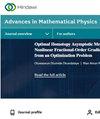求助PDF
{"title":"二元拓扑空间的分离性质","authors":"Xiaoli Qiang, S. Omidi, P. Sathishmohan, Lavanya Kakimallaiah, K. Rajalakshmi","doi":"10.1155/2023/4384483","DOIUrl":null,"url":null,"abstract":"<jats:p>In the present study, we introduce some new separation axioms for binary topological spaces. This new idea gives the notion of generalized binary (<jats:inline-formula>\n <math xmlns=\"http://www.w3.org/1998/Math/MathML\" id=\"M1\">\n <msub>\n <mrow>\n <mi>T</mi>\n </mrow>\n <mrow>\n <mn>0</mn>\n </mrow>\n </msub>\n </math>\n </jats:inline-formula>, <jats:inline-formula>\n <math xmlns=\"http://www.w3.org/1998/Math/MathML\" id=\"M2\">\n <msub>\n <mrow>\n <mi>T</mi>\n </mrow>\n <mrow>\n <mn>1</mn>\n </mrow>\n </msub>\n </math>\n </jats:inline-formula>, <jats:inline-formula>\n <math xmlns=\"http://www.w3.org/1998/Math/MathML\" id=\"M3\">\n <msub>\n <mrow>\n <mi>T</mi>\n </mrow>\n <mrow>\n <mn>2</mn>\n </mrow>\n </msub>\n </math>\n </jats:inline-formula>, <jats:inline-formula>\n <math xmlns=\"http://www.w3.org/1998/Math/MathML\" id=\"M4\">\n <msub>\n <mrow>\n <mi>T</mi>\n </mrow>\n <mrow>\n <mn>3</mn>\n </mrow>\n </msub>\n </math>\n </jats:inline-formula>, and <jats:inline-formula>\n <math xmlns=\"http://www.w3.org/1998/Math/MathML\" id=\"M5\">\n <msub>\n <mrow>\n <mi>T</mi>\n </mrow>\n <mrow>\n <mn>4</mn>\n </mrow>\n </msub>\n </math>\n </jats:inline-formula> spaces) and binary generalized semi (<jats:inline-formula>\n <math xmlns=\"http://www.w3.org/1998/Math/MathML\" id=\"M6\">\n <msub>\n <mrow>\n <mi>T</mi>\n </mrow>\n <mrow>\n <mn>0</mn>\n </mrow>\n </msub>\n </math>\n </jats:inline-formula>, <jats:inline-formula>\n <math xmlns=\"http://www.w3.org/1998/Math/MathML\" id=\"M7\">\n <msub>\n <mrow>\n <mi>T</mi>\n </mrow>\n <mrow>\n <mn>1</mn>\n </mrow>\n </msub>\n </math>\n </jats:inline-formula>, <jats:inline-formula>\n <math xmlns=\"http://www.w3.org/1998/Math/MathML\" id=\"M8\">\n <msub>\n <mrow>\n <mi>T</mi>\n </mrow>\n <mrow>\n <mn>2</mn>\n </mrow>\n </msub>\n </math>\n </jats:inline-formula>, <jats:inline-formula>\n <math xmlns=\"http://www.w3.org/1998/Math/MathML\" id=\"M9\">\n <msub>\n <mrow>\n <mi>T</mi>\n </mrow>\n <mrow>\n <mn>3</mn>\n </mrow>\n </msub>\n </math>\n </jats:inline-formula>, and <jats:inline-formula>\n <math xmlns=\"http://www.w3.org/1998/Math/MathML\" id=\"M10\">\n <msub>\n <mrow>\n <mi>T</mi>\n </mrow>\n <mrow>\n <mn>4</mn>\n </mrow>\n </msub>\n </math>\n </jats:inline-formula> spaces) using generalized binary open sets and binary generalized semi open sets to investigate their properties. We also provide adequate examples to assist and understand abstract concepts. In the similar manner, we begin researching the b-sg-<jats:inline-formula>\n <math xmlns=\"http://www.w3.org/1998/Math/MathML\" id=\"M11\">\n <msub>\n <mrow>\n <mi>T</mi>\n </mrow>\n <mrow>\n <mn>0</mn>\n </mrow>\n </msub>\n </math>\n </jats:inline-formula>, b-sg-<jats:inline-formula>\n <math xmlns=\"http://www.w3.org/1998/Math/MathML\" id=\"M12\">\n <msub>\n <mrow>\n <mi>T</mi>\n </mrow>\n <mrow>\n <mn>1</mn>\n </mrow>\n </msub>\n </math>\n </jats:inline-formula>, b-sg-<jats:inline-formula>\n <math xmlns=\"http://www.w3.org/1998/Math/MathML\" id=\"M13\">\n <msub>\n <mrow>\n <mi>T</mi>\n </mrow>\n <mrow>\n <mn>2</mn>\n </mrow>\n </msub>\n </math>\n </jats:inline-formula>, b-sg-<jats:inline-formula>\n <math xmlns=\"http://www.w3.org/1998/Math/MathML\" id=\"M14\">\n <msub>\n <mrow>\n <mi>T</mi>\n </mrow>\n <mrow>\n <mn>3</mn>\n </mrow>\n </msub>\n </math>\n </jats:inline-formula>, and b-sg-<jats:inline-formula>\n <math xmlns=\"http://www.w3.org/1998/Math/MathML\" id=\"M15\">\n <msub>\n <mrow>\n <mi>T</mi>\n </mrow>\n <mrow>\n <mn>4</mn>\n </mrow>\n </msub>\n </math>\n </jats:inline-formula> spaces in binary topological spaces. The study on the axioms is done over binary-<jats:inline-formula>\n <math xmlns=\"http://www.w3.org/1998/Math/MathML\" id=\"M16\">\n <msub>\n <mrow>\n <mi>T</mi>\n </mrow>\n <mrow>\n <mn>0</mn>\n </mrow>\n </msub>\n </math>\n </jats:inline-formula>, binary-<jats:inline-formula>\n <math xmlns=\"http://www.w3.org/1998/Math/MathML\" id=\"M17\">\n <msub>\n <mrow>\n <mi>T</mi>\n </mrow>\n <mrow>\n <mn>1</mn>\n </mrow>\n </msub>\n </math>\n </jats:inline-formula>, binary-<jats:inline-formula>\n <math xmlns=\"http://www.w3.org/1998/Math/MathML\" id=\"M18\">\n <msub>\n <mrow>\n <mi>T</mi>\n </mrow>\n <mrow>\n <mn>2</mn>\n </mrow>\n </msub>\n </math>\n </jats:inline-formula>, binary-<jats:inline-formula>\n <math xmlns=\"http://www.w3.org/1998/Math/MathML\" id=\"M19\">\n <msub>\n <mrow>\n <mi>T</mi>\n </mrow>\n <mrow>\n <mn>3</mn>\n </mrow>\n </msub>\n </math>\n </jats:inline-formula>, and binary-<jats:inline-formula>\n <math xmlns=\"http://www.w3.org/1998/Math/MathML\" id=\"M20\">\n <msub>\n <mrow>\n <mi>T</mi>\n </mrow>\n <mrow>\n <mn>4</mn>\n </mrow>\n </msub>\n </math>\n </jats:inline-formula> spaces, motivated to do the analysis of the spaces gb(b-gs)-<jats:inline-formula>\n <math xmlns=\"http://www.w3.org/1998/Math/MathML\" id=\"M21\">\n <msub>\n <mrow>\n <mi>T</mi>\n </mrow>\n ","PeriodicalId":49111,"journal":{"name":"Advances in Mathematical Physics","volume":" ","pages":""},"PeriodicalIF":1.0000,"publicationDate":"2023-04-03","publicationTypes":"Journal Article","fieldsOfStudy":null,"isOpenAccess":false,"openAccessPdf":"","citationCount":"0","resultStr":"{\"title\":\"The Separation Properties of Binary Topological Spaces\",\"authors\":\"Xiaoli Qiang, S. Omidi, P. Sathishmohan, Lavanya Kakimallaiah, K. Rajalakshmi\",\"doi\":\"10.1155/2023/4384483\",\"DOIUrl\":null,\"url\":null,\"abstract\":\"<jats:p>In the present study, we introduce some new separation axioms for binary topological spaces. This new idea gives the notion of generalized binary (<jats:inline-formula>\\n <math xmlns=\\\"http://www.w3.org/1998/Math/MathML\\\" id=\\\"M1\\\">\\n <msub>\\n <mrow>\\n <mi>T</mi>\\n </mrow>\\n <mrow>\\n <mn>0</mn>\\n </mrow>\\n </msub>\\n </math>\\n </jats:inline-formula>, <jats:inline-formula>\\n <math xmlns=\\\"http://www.w3.org/1998/Math/MathML\\\" id=\\\"M2\\\">\\n <msub>\\n <mrow>\\n <mi>T</mi>\\n </mrow>\\n <mrow>\\n <mn>1</mn>\\n </mrow>\\n </msub>\\n </math>\\n </jats:inline-formula>, <jats:inline-formula>\\n <math xmlns=\\\"http://www.w3.org/1998/Math/MathML\\\" id=\\\"M3\\\">\\n <msub>\\n <mrow>\\n <mi>T</mi>\\n </mrow>\\n <mrow>\\n <mn>2</mn>\\n </mrow>\\n </msub>\\n </math>\\n </jats:inline-formula>, <jats:inline-formula>\\n <math xmlns=\\\"http://www.w3.org/1998/Math/MathML\\\" id=\\\"M4\\\">\\n <msub>\\n <mrow>\\n <mi>T</mi>\\n </mrow>\\n <mrow>\\n <mn>3</mn>\\n </mrow>\\n </msub>\\n </math>\\n </jats:inline-formula>, and <jats:inline-formula>\\n <math xmlns=\\\"http://www.w3.org/1998/Math/MathML\\\" id=\\\"M5\\\">\\n <msub>\\n <mrow>\\n <mi>T</mi>\\n </mrow>\\n <mrow>\\n <mn>4</mn>\\n </mrow>\\n </msub>\\n </math>\\n </jats:inline-formula> spaces) and binary generalized semi (<jats:inline-formula>\\n <math xmlns=\\\"http://www.w3.org/1998/Math/MathML\\\" id=\\\"M6\\\">\\n <msub>\\n <mrow>\\n <mi>T</mi>\\n </mrow>\\n <mrow>\\n <mn>0</mn>\\n </mrow>\\n </msub>\\n </math>\\n </jats:inline-formula>, <jats:inline-formula>\\n <math xmlns=\\\"http://www.w3.org/1998/Math/MathML\\\" id=\\\"M7\\\">\\n <msub>\\n <mrow>\\n <mi>T</mi>\\n </mrow>\\n <mrow>\\n <mn>1</mn>\\n </mrow>\\n </msub>\\n </math>\\n </jats:inline-formula>, <jats:inline-formula>\\n <math xmlns=\\\"http://www.w3.org/1998/Math/MathML\\\" id=\\\"M8\\\">\\n <msub>\\n <mrow>\\n <mi>T</mi>\\n </mrow>\\n <mrow>\\n <mn>2</mn>\\n </mrow>\\n </msub>\\n </math>\\n </jats:inline-formula>, <jats:inline-formula>\\n <math xmlns=\\\"http://www.w3.org/1998/Math/MathML\\\" id=\\\"M9\\\">\\n <msub>\\n <mrow>\\n <mi>T</mi>\\n </mrow>\\n <mrow>\\n <mn>3</mn>\\n </mrow>\\n </msub>\\n </math>\\n </jats:inline-formula>, and <jats:inline-formula>\\n <math xmlns=\\\"http://www.w3.org/1998/Math/MathML\\\" id=\\\"M10\\\">\\n <msub>\\n <mrow>\\n <mi>T</mi>\\n </mrow>\\n <mrow>\\n <mn>4</mn>\\n </mrow>\\n </msub>\\n </math>\\n </jats:inline-formula> spaces) using generalized binary open sets and binary generalized semi open sets to investigate their properties. We also provide adequate examples to assist and understand abstract concepts. In the similar manner, we begin researching the b-sg-<jats:inline-formula>\\n <math xmlns=\\\"http://www.w3.org/1998/Math/MathML\\\" id=\\\"M11\\\">\\n <msub>\\n <mrow>\\n <mi>T</mi>\\n </mrow>\\n <mrow>\\n <mn>0</mn>\\n </mrow>\\n </msub>\\n </math>\\n </jats:inline-formula>, b-sg-<jats:inline-formula>\\n <math xmlns=\\\"http://www.w3.org/1998/Math/MathML\\\" id=\\\"M12\\\">\\n <msub>\\n <mrow>\\n <mi>T</mi>\\n </mrow>\\n <mrow>\\n <mn>1</mn>\\n </mrow>\\n </msub>\\n </math>\\n </jats:inline-formula>, b-sg-<jats:inline-formula>\\n <math xmlns=\\\"http://www.w3.org/1998/Math/MathML\\\" id=\\\"M13\\\">\\n <msub>\\n <mrow>\\n <mi>T</mi>\\n </mrow>\\n <mrow>\\n <mn>2</mn>\\n </mrow>\\n </msub>\\n </math>\\n </jats:inline-formula>, b-sg-<jats:inline-formula>\\n <math xmlns=\\\"http://www.w3.org/1998/Math/MathML\\\" id=\\\"M14\\\">\\n <msub>\\n <mrow>\\n <mi>T</mi>\\n </mrow>\\n <mrow>\\n <mn>3</mn>\\n </mrow>\\n </msub>\\n </math>\\n </jats:inline-formula>, and b-sg-<jats:inline-formula>\\n <math xmlns=\\\"http://www.w3.org/1998/Math/MathML\\\" id=\\\"M15\\\">\\n <msub>\\n <mrow>\\n <mi>T</mi>\\n </mrow>\\n <mrow>\\n <mn>4</mn>\\n </mrow>\\n </msub>\\n </math>\\n </jats:inline-formula> spaces in binary topological spaces. The study on the axioms is done over binary-<jats:inline-formula>\\n <math xmlns=\\\"http://www.w3.org/1998/Math/MathML\\\" id=\\\"M16\\\">\\n <msub>\\n <mrow>\\n <mi>T</mi>\\n </mrow>\\n <mrow>\\n <mn>0</mn>\\n </mrow>\\n </msub>\\n </math>\\n </jats:inline-formula>, binary-<jats:inline-formula>\\n <math xmlns=\\\"http://www.w3.org/1998/Math/MathML\\\" id=\\\"M17\\\">\\n <msub>\\n <mrow>\\n <mi>T</mi>\\n </mrow>\\n <mrow>\\n <mn>1</mn>\\n </mrow>\\n </msub>\\n </math>\\n </jats:inline-formula>, binary-<jats:inline-formula>\\n <math xmlns=\\\"http://www.w3.org/1998/Math/MathML\\\" id=\\\"M18\\\">\\n <msub>\\n <mrow>\\n <mi>T</mi>\\n </mrow>\\n <mrow>\\n <mn>2</mn>\\n </mrow>\\n </msub>\\n </math>\\n </jats:inline-formula>, binary-<jats:inline-formula>\\n <math xmlns=\\\"http://www.w3.org/1998/Math/MathML\\\" id=\\\"M19\\\">\\n <msub>\\n <mrow>\\n <mi>T</mi>\\n </mrow>\\n <mrow>\\n <mn>3</mn>\\n </mrow>\\n </msub>\\n </math>\\n </jats:inline-formula>, and binary-<jats:inline-formula>\\n <math xmlns=\\\"http://www.w3.org/1998/Math/MathML\\\" id=\\\"M20\\\">\\n <msub>\\n <mrow>\\n <mi>T</mi>\\n </mrow>\\n <mrow>\\n <mn>4</mn>\\n </mrow>\\n </msub>\\n </math>\\n </jats:inline-formula> spaces, motivated to do the analysis of the spaces gb(b-gs)-<jats:inline-formula>\\n <math xmlns=\\\"http://www.w3.org/1998/Math/MathML\\\" id=\\\"M21\\\">\\n <msub>\\n <mrow>\\n <mi>T</mi>\\n </mrow>\\n \",\"PeriodicalId\":49111,\"journal\":{\"name\":\"Advances in Mathematical Physics\",\"volume\":\" \",\"pages\":\"\"},\"PeriodicalIF\":1.0000,\"publicationDate\":\"2023-04-03\",\"publicationTypes\":\"Journal Article\",\"fieldsOfStudy\":null,\"isOpenAccess\":false,\"openAccessPdf\":\"\",\"citationCount\":\"0\",\"resultStr\":null,\"platform\":\"Semanticscholar\",\"paperid\":null,\"PeriodicalName\":\"Advances in Mathematical Physics\",\"FirstCategoryId\":\"101\",\"ListUrlMain\":\"https://doi.org/10.1155/2023/4384483\",\"RegionNum\":4,\"RegionCategory\":\"物理与天体物理\",\"ArticlePicture\":[],\"TitleCN\":null,\"AbstractTextCN\":null,\"PMCID\":null,\"EPubDate\":\"\",\"PubModel\":\"\",\"JCR\":\"Q3\",\"JCRName\":\"PHYSICS, MATHEMATICAL\",\"Score\":null,\"Total\":0}","platform":"Semanticscholar","paperid":null,"PeriodicalName":"Advances in Mathematical Physics","FirstCategoryId":"101","ListUrlMain":"https://doi.org/10.1155/2023/4384483","RegionNum":4,"RegionCategory":"物理与天体物理","ArticlePicture":[],"TitleCN":null,"AbstractTextCN":null,"PMCID":null,"EPubDate":"","PubModel":"","JCR":"Q3","JCRName":"PHYSICS, MATHEMATICAL","Score":null,"Total":0}
引用次数: 0
引用
批量引用
The Separation Properties of Binary Topological Spaces
In the present study, we introduce some new separation axioms for binary topological spaces. This new idea gives the notion of generalized binary (
T
0
,
T
1
,
T
2
,
T
3
, and
T
4
spaces) and binary generalized semi (
T
0
,
T
1
,
T
2
,
T
3
, and
T
4
spaces) using generalized binary open sets and binary generalized semi open sets to investigate their properties. We also provide adequate examples to assist and understand abstract concepts. In the similar manner, we begin researching the b-sg-
T
0
, b-sg-
T
1
, b-sg-
T
2
, b-sg-
T
3
, and b-sg-
T
4
spaces in binary topological spaces. The study on the axioms is done over binary-
T
0
, binary-
T
1
, binary-
T
2
, binary-
T
3
, and binary-
T
4
spaces, motivated to do the analysis of the spaces gb(b-gs)-
T


